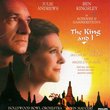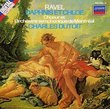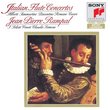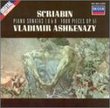| All Artists: George Lloyd, Dennis Simons, BBC Philharmonic Orchestra Title: George Lloyd: Symphony No. 5 Members Wishing: 0 Total Copies: 0 Label: Albany Records Release Date: 10/24/2006 Genre: Classical Styles: Historical Periods, Modern, 20th, & 21st Century, Symphonies Number of Discs: 1 SwapaCD Credits: 1 UPC: 034061002222 |
Search - George Lloyd, Dennis Simons, BBC Philharmonic Orchestra :: George Lloyd: Symphony No. 5
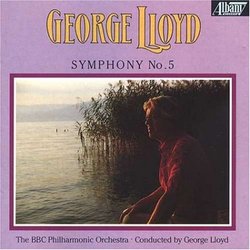 | George Lloyd, Dennis Simons, BBC Philharmonic Orchestra George Lloyd: Symphony No. 5 Genre: Classical
The Fifth Symphony is a flaming masterpiece. It begins with a gorgeous pastoral scored for small orchestra (without trumpets, trombones and percussion), followed by a solemn chorale for brass, winds, percussion and lower... more » |
Larger Image |
CD DetailsSynopsis
Amazon.com The Fifth Symphony is a flaming masterpiece. It begins with a gorgeous pastoral scored for small orchestra (without trumpets, trombones and percussion), followed by a solemn chorale for brass, winds, percussion and lower strings. The central movement is a gossamer scherzo in quick waltz tempo, with a sorrowful slow movement (shades of Tchaikovsky!) next and a zippy finale to round things off in high spirits. The orchestration is absolutely luminous, the tunes first rate, and the whole thing adds up to as fine a Romantic symphony as you'll ever hear. No rational fan of classical music will be able to resist this marvelous piece, and both the performance and recording are a fine as the music itself. --David Hurwitz Similarly Requested CDs
|
CD ReviewsNever heard of George Lloyd? Try this! Rodney Gavin Bullock | Winchester, Hampshire Angleterre | 10/16/2001 (5 out of 5 stars) "The British specialise in neglected composers. Sometimes, when they are hobbling around on sticks and are hard of hearing, someone finds an old score in the archives and thinks, "This looks good. Why don't we hear it? Are they still alive?" And so their music is rediscovered and the bewildered old chap is dragged out of obscurity. This happened to Havergal Brian and to George Lloyd, though he was not on sticks and looked extraordinarily young and trendy with his silvery mullet. He was 'discovered' by someone working at the BBC classical station, Radio 3 and a symphony was given a studio performance. Someone else sent a tape to the boss at Albany Records and as a result, all the symphonies and much else were recorded over the following years, a wonderful achievement.Lloyd wrote an fine cycle of symphonies, the central ones being the greatest. The fifth was written in the hot summer of 1947 in idyllic surroundings by the side of Lake of Neuchâtel. Lasting nearly an hour, it shows Lloyd's mastery of large forms. Each of the five movements omits specific groups of instruments, giving a different palette of colours to each. The opening Pastorale begins with a long-breathed, lyrical melody which he proceeds to develop. This material is never far away and the whole movement shows Lloyd's feel for a memorable tune.The Corale is for wind, low strings and percussion only. It is pervaded by a rhythmic motif, sinister and benign by turns.Next comes a Rondo which is light, tuneful, inventive and gloriously orchestrated. There is a particularly fine fast waltz melody.The Lamento is the emotional heart of the symphony. The full orchestra is used for the first time and the music is elegiac and full of tears - and perhaps anger. Lloyd was in the process of recovering from shell-shock (or post-traumatic syndrome, as we now call it) after dreadful experiences while serving on the Arctic convoys during WW2. Does this music express the mental anguish he had endured? It is heart-rending stuff and very beautiful. The ending with harp arpeggios followed by string chords brings this fine movement to a mysterious close.In the Finale, 'everything is brought in to make an exhilarating a sound as possible' as George Lloyd says in the notes. The music is very rhythmic and great fun.The recording is excellent. The BBC Philharmonic is one of several BBC house orchestras and is highly respected - one can see why on this disc. George Lloyd conducts and has written the notes to the music. The notes themselves are rather brief, as with the rest of Albany's series, but they are sufficient." A Wonderful Symphony! K. DANIELSON | New Castle, Pa USA | 09/28/1999 (5 out of 5 stars) "This is simply a wonderful symphony! It seems incomprehensible to me why symphony orchestras don't perform this work - audiences would love it. I highly recommend this CD to anyone looking for an unknown work written in an incredibly accessible and romantic style!" A joyous work Benjamin | UK | 10/13/2007 (5 out of 5 stars) "How has this English composer been kept a secret for so long? His fifth symphony was written in 1947 when the composer was staying in Corcelettes on the Lake of Neuchâtel, Switzerland. The composer says the five months spent there were probably the happiest of his life; his fifth symphony seems to attest to this, it is a joyous and immediately accessible work which concludes with a thrilling Finale with strong rhythms and typical broad melodies - and perhaps some of the catchiest tunes I've yet encountered from Lloyd.
The recording and sound are of top quality - highly recommended. " |

 Track Listings (5) - Disc #1
Track Listings (5) - Disc #1